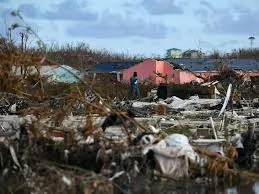There are international treaties in place to stop the spread and use of nuclear weapons, so hopefully you'll never really need to know any of this information.
It has been nearly 80 years since two nuclear bombs were detonated over the Japanese cities of Hiroshima and Nagasaki, killing at least 129,000 people and causing devastating long-term health effects.
An article by Science Alert mentions that these are the only two cases in which nuclear weapons have been used in war, but the truth is that there are approximately 12,700 warheads left in the world today. So, what would happen if a nuclear war broke out tomorrow?
Don't panic, this is just an assumption. But in the video below, the AsapSCIENCE team uses nuclear bomb science to predict how likely you are to survive, but let's just say that in the event of a nuclear explosion, you might want to wear white.
First, let's agree that there is no clear way to estimate the impact of a single nuclear bomb, because it depends on many factors, including the weather on the day it fell, the time of day it exploded, the geographical layout of the place of the explosion, and whether the explosion occurred on the ground or in the air. But in general, there are factors that can affect your likelihood of survival.
What happens when a nuclear bomb explodes?
As the video shows, approximately 35% of the energy of a nuclear explosion is released in the form of thermal radiation, and since thermal radiation travels at nearly the speed of light, the first thing that will strike you is a flash of light and heat.
The light itself is enough to cause something called sudden blindness, which is usually a temporary form of vision loss that can last for a few minutes. The ISAP Science video shows a 1-megaton bomb, which is 80 times larger than the bomb detonated over Hiroshima, but much smaller than many modern nuclear weapons.
For a bomb of this size, people 21 kilometers away would be temporarily blinded on a clear day, and people 85 kilometers away would be temporarily blinded on a clear night.
The effect of heat, pressure and wind
Heat is a problem for those closest to the explosion, as it can cause first-degree burns up to 11 kilometers away, and third-degree burns - the kind that destroys skin tissue and works to ulcerate it - can occur to anyone 8 kilometers away, and from Third-degree burns that cover more than 24% of the body are likely to be fatal if people do not receive medical attention right away.
These distances are variable, depending not only on the weather, but also on what you're wearing. White clothes can reflect some of the blast's energy, while dark clothes absorb it, but this isn't likely to make much of a difference to the unlucky ones who will be in the center of the blast.
Temperatures near the site of the bomb detonation during the Hiroshima explosion were estimated at 300,000 degrees Celsius, nearly 300 times the temperatures at which corpses are cremated, so the human body decomposes almost instantly to elemental elements, such as carbon.
But for those a little further from the center of the explosion, there are other effects to consider beyond the heat. The shock of a nuclear explosion also blows air away from the blast site, causing sudden changes in atmospheric pressure that can crush things and demolish buildings.
Within a 6 km radius of a 1 megaton bomb, the blast waves will produce 180 metric tons of force on the walls of all two-story buildings, a wind speed of 255 km/h, and in a 1 km radius the peak pressure will be 4 times that amount, The wind speed can reach 756 km/h.
Practically speaking, humans can handle that much stress, but most people would be killed by falling buildings, and if you somehow survived all of that, there's still radioactive poisoning to contend with, nuclear precipitation.
Long term effects
The ESAP Science team touches on this in the video above, but the ongoing effects on the planet last longer than you might expect. For example, a simulation study published in 2019 found that a nuclear war between the United States and Russia would plunge the Earth into a nuclear winter in a matter of days due to levels of Smoke emitted into the atmosphere.
We also know that radioactive particles can travel great distances; A recent study has found that radiocarbon remnants from Cold War nuclear bomb tests were found along the way in the Mariana Trench, the deepest point in the world's oceans.
Again, this is all hypothetical, as there are international treaties in place to stop the spread and use of nuclear weapons, so hopefully you'll never need to know any of this information for real.
However, to learn more about the current status of nuclear weapons in the world, including bomb size, you can visit the Nuclear Notebook at the Bulletin of the Atomic Scientists.
Tags:
awakening conscience
cambridge science
electrical sciences
genomic sciences
geo science
life science
live science
neuroscience
science
science magazine
space science





